|
 | Anglo Saxon History |  | |
| | The Cinque Ports and Southern England |
|---|
| |
|---|
| Introduction |
|---|
I will be trying to show how the Cinque Ports developed from the late Saxon times until modern times.
|
The Creation of the Cinque Ports ▲
|
|---|
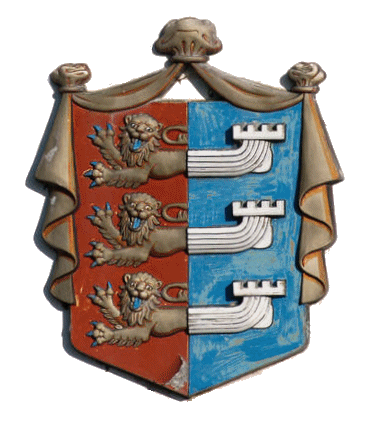 Originally created by the ports of Dover, Sandwich and Romney during Edward the Confessor's times for mutual protection
and trade.(the original charter was probably created out of a need to purchase the loyalty of a group of potentially
troublesome ports that were of strategic importance to the control of cross-Channel traffic)
Originally created by the ports of Dover, Sandwich and Romney during Edward the Confessor's times for mutual protection
and trade.(the original charter was probably created out of a need to purchase the loyalty of a group of potentially
troublesome ports that were of strategic importance to the control of cross-Channel traffic)
Hastings and Hythe probably joined just after the Norman Conquest to create the original Confederation of Cinque Ports.
By AD1190 Rye and Winchelsea who were part of the Hastings contingent had been accepted as 'Ancient Towns'.
As an aside William the Conqueror landed near Hastings however Romney was reported as being destroyed because
they killed all the sailors from some of the Norman ships.
This was most likely caused by some of the Norman ships that were overloaded or taking on water, and the area near
Romney/Langport was the nearest place to land.
Once Harold had been defeated William went to Romney and then Dover before going to London, this was to ensure that the
original three ports were going to be loyal to William and were not going to provide ships to the remaining Saxon Earls
to provide sea transport so his troops were cut off.
| | |
|---|
| Documentary Evidence - Anglo Saxon Chronicles ▲ |
|---|
The following texts are extracted from the Anglo Saxon Chronicles and refer to the Ports.
1015AD At the same time came King Knute to Sandwich, and went soon all about Kent into Wessex, until he came
to the mouth of the Frome; and then plundered in Dorset, and in Wiltshire, and in Somerset. King Ethelred, meanwhile,
lay sick at Corsham; and Alderman Edric collected an army there, and Edmund the etheling in the north. When they came
together, the alderman designed to betray Edmund the etheling, but he could not; whereupon they separated without an
engagement, and sheered off from their enemies. Alderman Edric then seduced forty ships from the king, and submitted to
Knute. The West-Saxons also submitted, and gave hostages, and horsed the army. And he continued there until midwinter.
1046AD And in this same year King Edward went out to Sandwich with a great fleet. And Sweyn the earl, son of
Godwin the earl, came in to Bosham with seven ships; and he obtained the king's protection, and he was promised that he
should be held worthy of everything which he before possessed. Then Harold the earl, his brother, and Beorn the earl
contended that he should not be held worthy of any of the things which the king had granted to them: but a protection of
four days was appointed him to go to his ships. Then befell it during this, that word came to the king that hostile
ships lay westward, and were ravaging. Then went Godwin the earl west about with two of the king's ships; the one
commanded Harold the earl, and the other Tosty his brother; and forty-two of the people's ships. Then Harold the earl
was removed from the king's ship which Harold the earl before had commanded. Then went they west to Pevensey,
and lay there weather-bound. Upon this, after two days, then came Sweyn the earl thither, and spoke with his father,
and with Beorn the earl, and begged of Beorn that he would go with him to the king at Sandwich, and help him to
the king's friendship: and he granted it. Then went they as if they would go to the king. Then whilst they were riding,
then begged Sweyn of him that he would go with him to his ships: saying that his seamen would depart from him unless he
should at the soonest come thither. Then went they both where his ships lay. When they came thither, then begged Sweyn
the earl of him that he would go with him on ship-board. He strenuously refused, so long as until his seamen seized
him, and threw him into the boat, and bound him, and rowed to the ship, and put him there aboard. Then they hoisted up
their sails and ran west to Exmouth, and had him with them until they slew him: and they took the body and buried it in
a church.
1049AD Then the king and all the army proclaimed Sweyne an outlaw. A little before this the men of Hastings and
thereabout fought his two ships with their ships, and slew all the men, and brought the ships to Sandwich to the
king. Eight ships had he, ere he betrayed Beorn; afterwards they all forsook him except two; whereupon he went eastward
to the land of Baldwin, and sat there all the winter at Bruges, in full security.
1050AD Thither also came Sweyn the earl, who before had gone from this land to Denmark, and who there had ruined
himself with the Danes. He came thither with false pretences; saying that he would again be obedient to the king. And
Beorn the earl promised him that he would be of assistance to him. Then, after the reconciliation of the emperor and of
Baldwin, many of the ships went home, and the king remained behind at Sandwich with a few ships; and Godwin the
earl also went with forty-two ships from Sandwich to Pevensey, and Beorn the earl went with him. Then was
it made known to the king that Osgood lay at Ulps with thirty-nine ships; and the king then sent after the ships which
before had gone home, that he might send after him. And Osgod fetched his wife from Bruges, and they went back again
with six ships. And the others landed in Sussex [Essex] at Eadulf-ness, and there did harm, and went again to their
ships: and then a strong wind came against them, so that they were all destroyed, except four, whose crews were slain
beyond sea. While Godwin the earl and Beorn the earl lay at Pevensey, then came Sweyn the earl, and begged Beorn
the earl, with fraud, who was his uncle's son, that he would be his companion to the king at Sandwich, and better
his affairs with him.
1051AD And then came Eustace [Earl of Boulogne] from beyond sea soon after the bishop, and went to the king, and spoke
with him that which he then would, and went then homeward. When he came to Canterbury, east, then took he refreshment
there, and his men, and went to Dover. When he was some mile or more, on this side of Dover, then he put
on his breast-plate, and so did all his companions, and went to Dover. When they came thither, then would they
lodge themselves where they chose. Then came one of his men, and would abide in the house of a householder against his
will, and wounded the householder; and the householder slew the other. Then Eustace got upon his horse, and his
companions upon theirs; and they went to the householder, and slew him within his own dwelling; and they went up towards
the town, and slew, as well within as without, more than twenty men. And the townsmen slew nineteen men on the other
side, and wounded they knew not how many. And Eustace escaped with a few men, and went again to the king, and made
known to him, in part, how they had fared. And the king became very wroth with the townsmen. And the king sent off
Godwin the earl, and bade him go into Kent in a hostile manner to Dover: for Eustace had made it appear to the
king, that it had been more the fault of the townsmen than his: but it was not so. And the earl would not consent to
the inroad, because he was loth to injure his own people.
1052AD In the same year advised the king and his council, that ships should be sent out to Sandwich, and that Earl Ralph
and Earl Odda should be appointed headmen thereto. Then went Earl Godwin out from Bruges with his ships to Ysendyck;
and sailed forth one day before midsummer-eve, till he came to the Ness that is to the south of Romney.
When it came to the knowledge of the earls out at Sandwich, they went out after the other ships; and a land-force was
also ordered out against the ships. Meanwhile Earl Godwin had warning, and betook himself into Pevensey: and the
weather was so boisterous, that the earls could not learn what had become of Earl Godwin. But Earl Godwin then went out
again until he came back to Bruges; and the other ships returned back again to Sandwich. Then it was advised
that the ships should go back again to London, and that other earls and other pilots should be appointed over them. But
it was delayed so long that the marine army all deserted; and they all betook themselves home. When Earl Godwin
understood that, he drew up his sail and his ship: and they went west at once to the Isle of Wight; and landing there,
they plundered so long that the people gave them as much as they required of them. Then proceeded they westward until
they came to Portland, where they landed and did as much harm as they could possibly do. Meanwhile Harold had gone out
from Ireland with nine ships, and came up at Potlock with his ships to the mouth of the Severn, near the boundaries of
Somerset and Devonshire, and there plundered much. The land-folk collected against him, both from Somerset and from
Devonshire: but he put them to flight, and slew there more than thirty good thanes, besides others; and went soon after
about Penwithstert, where was much people gathered against him; but he spared not to provide himself with meat, and went
up and slew on the spot a great number of the people -- seizing in cattle, in men, and in money, whatever he could.
Then went he eastward to his father; and they went both together eastward until they came to the Isle of Wight, where
they seized whatever had been left them before. Thence they went to Pevensey, and got out with them as many
ships as had gone in there, and so proceeded forth till they came to the Ness; getting all the ships that were
at Romney, and at Hithe, and at Folkstone. Then ordered King Edward to fit out forty smacks that
lay at Sandwich many weeks, to watch Earl Godwin, who was at Bruges during the winter; but he nevertheless came
hither first to land, so as to escape their notice. And whilst he abode in this land, he enticed to him all the Kentish
men, and all the boatmen from Hastings, and everywhere thereabout by the sea-coast, and all the men of Essex and
Sussex and Surrey, and many others besides. Then said they all that they would with him live or die. When the fleet
that lay at Sandwich had intelligence about Godwin's expedition, they set sail after him; but he escaped them,
and betook himself wherever he might: and the fleet returned to Sandwich, and so homeward to London. When Godwin
understood that the fleet that lay at Sandwich was gone home, then went he back again to the Isle of Wight, and
lay thereabout by the sea-coast so long that they came together -- he and his son Earl Harold. But they did no great
harm after they came together; save that they took meat, and enticed to them all the land-folk by the sea-coast and also
upward in the land. And they proceeded toward Sandwich, ever alluring forth with them all the boatmen that they
met; and to Sandwich they came with an increasing army. They then steered eastward round to Dover, and
landing there, took as many ships and hostages as they chose, and so returned to Sandwich, where they did the
same; and men everywhere gave them hostages and provisions, wherever they required them.
| | Anglo Saxon Chronicles - Port Loyalties pre 1066AD ▲ |
|---|
It would seem that:
Sandwich always supported the King, and that this was the main fleet location, and were likely
to be Norman sympathisers.
Eustace [Earl of Boulogne] had killed a number of Dover townsfolk, so they would have been
Godwin supporters especially after Godwin refused to punish the town.
Hythe and Romney and Folkestone also appeared
to be Godwin supporters, further support for this is the fact that in 1066AD Norman ships landing at Romney were
destroyed and then William attacked and punished the area after the battle of Hastings. There is also the fact that
these three ports are next to Dover and in Kent so most likely influenced by Dover.
Hastings had attacked Sweyne, Earl Godwins son so were most likely Norman supporters, and could
have been influenced by the monks from Fecamp who had lands at Ramslie between Rye and Hastings, given to them in 1017AD
when Cnut’s Queen, Emma of Normandy persuaded the King to grant it to the Norman Abbey of Fécamp.
Pevensey would also appear to be Godwin Supporters as Godwin seemed to be using Pevensey on a
regular basis as an anchorage to protect his ships from the weather, and possibly to rebuild his ships from
Andredsweald.
| | Documentary Evidence - Domesday Book 1086AD ▲ |
|---|
The Domesday Book of 1086AD was a key tool in the taxation system of medieval England, used to assess taxes and
other public obligations on almost every estate in the country:
Taxation
The Domesday Book introduced a new taxation system for each estate, allowing the king to quickly raise more money from
landholders. The book assessed taxes on land, such as the hide, which was both an estimate of area and the tax due from
that area.
Public obligations
The Domesday Book also assessed other public obligations, such as naval and military service. Landowners knew their
liabilities for each public duty, which they calculated by multiplying the rate of tax or service by the number of
assessed units they owned.
The following texts are extracted from the Kent Domesday Book and refer to the Ports.
Dover
The Burgesses gave 20 ships to the King once per year for 15 days. In each ship there were 21 men. They did this because
he had given over to them full jurisdiction.
Whoever lived permanently in the town and paid customary dues to the King was exempt from toll throughout the whole of
England.
All these customs were there when King William came to England.
Sandwich
It pays the same service to the King as Dover.
Langport (New Romney)
But the King has all the service from them,they themselves have all the customary dues and other forfeitures for service
at sea: they are in the hands of the King.
Romney
The King has all the service from them; they are exempt because of service at sea from all customary dues except three:
theft, breach of the peace and highway robbery.
There is no mention of any ports in Sussex having the same benefits.
Hastings
Not mentioned at all in the Sussex Domesday book
Pevensey
Not mentioned at all in the Sussex Domesday book, its only mention is the Borough of Pevensey
There is a possibility that the two Sussex ports were complicit with the Norman invasion and therefore not recorded for
tax purposes.
A second possibility is that they were not added as a tax favour to Bishop Odo who was important in the Battle of
Hastings.
From the Domesday entries it would seem likely that the Ports above were in a loose alliance before
1086AD, we have other evidence from the Anglo Saxon Chronicles that seem to corroborate this.
| | |
|---|
| Documentary Evidence - Other Early Documents and Charters ▲ |
|---|
Early mentions of the Cinque ports are as follows
1155AD HENRY II
The five(Cinque) Ports are individually mentioned in the Pipe Rolls (accounts of the royal income and expenditure)
1189AD RICHARD I (The Lionheart)
At his Coronation his canopy was borne over him by the Barons of Dover and the Cinque Ports
1191AD A Charter for Rye and Winchelsea
1205AD JOHN
Charter for Hastings, New Romney, Hythe, Dover, Sandwich, Rye and WInchelsea confirming an earlier Charter
1205AD JOHN
Charter for Lydd and Dengemarsh, Members of Romney
| | |
|---|
Documentary Evidence - The First Collective Charter ▲
|
|---|

The earliest Charter granted to the Ports collectively was dated 28 May by Henry III in AD1260.
The first major official document of the Cinque Ports was created in a Royal Charter in AD1278 by Edward I, five(french
cinque) ports were to maintain ships and defences for the Crown in case of attack and war,this document also referred to
earlier charters which are now lost.
The chief obligation laid upon the ports, as a corporate duty, was to provide 57 ships for 15 days' service to
the king annually without payment, each port fulfilling a proportion of the whole duty.
In return the towns received the following privileges:
- Exemption from tax and tallage
tax and land tax
- right of soc and sac
local laws and justice
- tol and team
tax goods passing through and exemption of government tolls
- blodwit
the right to punish shedders of blood
- fledwit
the right to punish those who were seized in an attempt to escape from justice
- pillory and tumbril
punishment of offenders
- infangentheof and outfangentheof
local punishment of thieves
- mundbryce
the breaking into or violation of a man's mund or property in order to erect banks or dikes as a defence against
the sea
- waifs and strays
the landowner to take ownership of goods or animals left or straying onto their land
- flotsam and jetsam and ligan
flotsam - goods from a sunken vessel
jetsam - goods thrown from a vessel to make it lighter etc
ligan - object attached to a buoy, i.e smuggled goods
In effect the Laws of the land did not apply to the Cinque Ports.
| | |
|---|
Map of the Cinque Ports pre the 1287AD Storm ▲
|
|---|
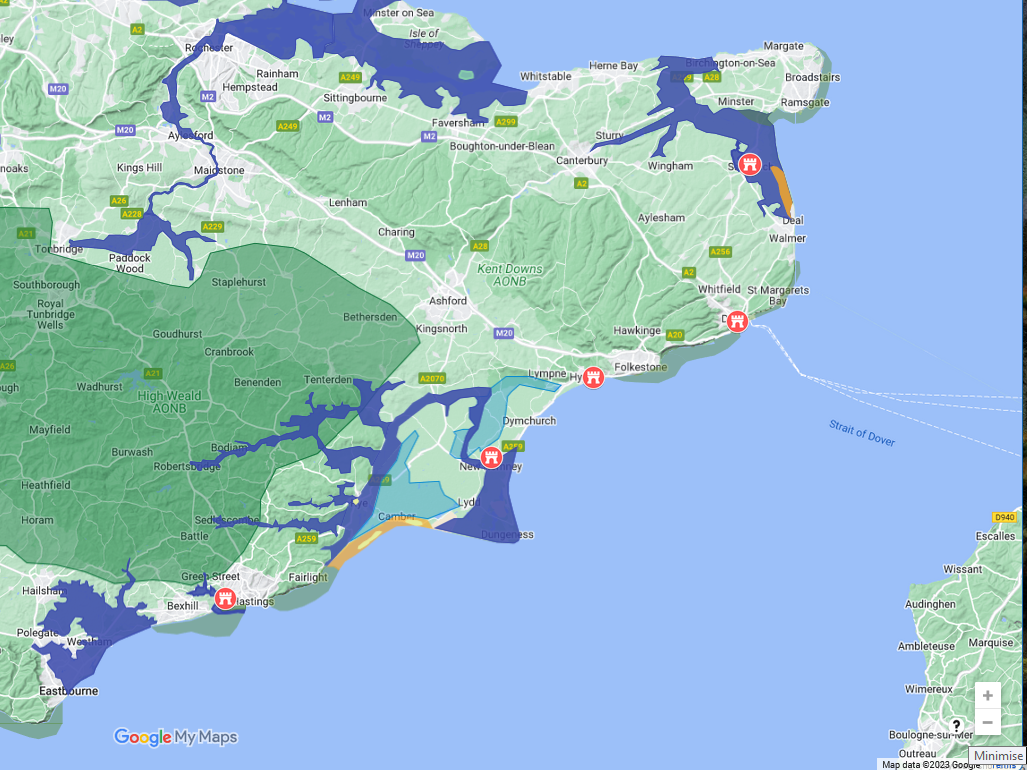 This Map is based on a Google Relief Map and shows the high tide level at 4.5
metres higher than today to reflect the high tide level at the time
This Map is based on a Google Relief Map and shows the high tide level at 4.5
metres higher than today to reflect the high tide level at the time
Hastings was a fishing and major shipbuilding centre due to its proximity to the vast forest of Andredsweald
it was in its own protected harbour most likely in the Filsham Valley.
New Romney(Langport) was a fishing centre, but was the entrance to the Rother where other ships were made in
the Newenden/Bodiam areas again due to the proximity of Andredsweald
Hythe was a fishing centre but was relatively close to modern France
Dover was a fishing centre but was the nearest point to modern France
Sandwich was another fishing centre but was protected by a shingle bar projecting northwards from Deal and
protected the Wantsum channel between Kent and the Isle of Thanet.
The five ports are fairly evenly spread out along the coast providing good response speed to any offense from Europe
| | |
|---|
The AD1287 storm on the South East coast of England ▲
|
|---|
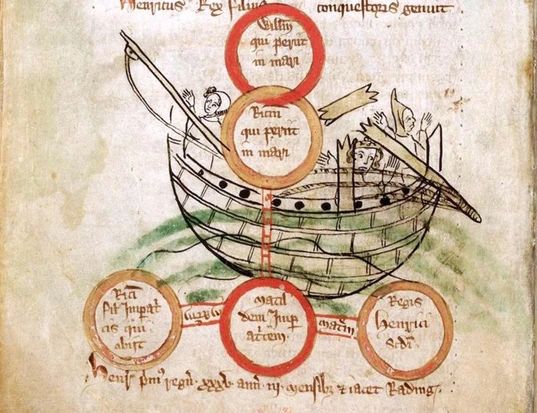 On the South coast of England in AD1287 there arose a dreadful storm which in changed the shape of the coastline.
On the South coast of England in AD1287 there arose a dreadful storm which in changed the shape of the coastline.
The harbour at Hastings(this was in the Filsham valley) was destroyed and its entrance blocked by shingle, the old town
of Winchelsea and Broomhill(which were on islands offshore from modern Winchelsea) were washed away and abandoned.
Winchelsea was resurrected on the hill behind Ihamme overlooking Rye and old Winchelsea, and is now a beautiful town
with one of the first grid layouts in England.
The thriving port of New Romney was turned into a landlocked town when massive quantities of shingle from further down
the coast, along with mud and soil, inundated the town. This completely filled the harbour, blocked the river Rother and
left New Romney nearly a mile from the sea with its church about 1 metre below the land and stains on the pillars
marking the level of the flood.
The river Rother, which ran through the town, was blocked by the storm and found a new outlet to the sea at Rye, 15
miles away, a course that the river still takes today.
| | |
|---|
The AD1287 storm and its effect on the independance of the Cinque Ports ▲
|
|---|
The economic effect this storm had on the Cinque Ports was that to remain independent they were still obliged to provide
57 vessels for 15 days' service to the king. Now this was impossible for the 5 ports and the 2 ancient towns as a
significant number of ships had been destroyed by the storm, and also harbours blocked and towns destroyed.
|
Map of the Cinque Ports after the 1287AD Storm ▲
|
|---|
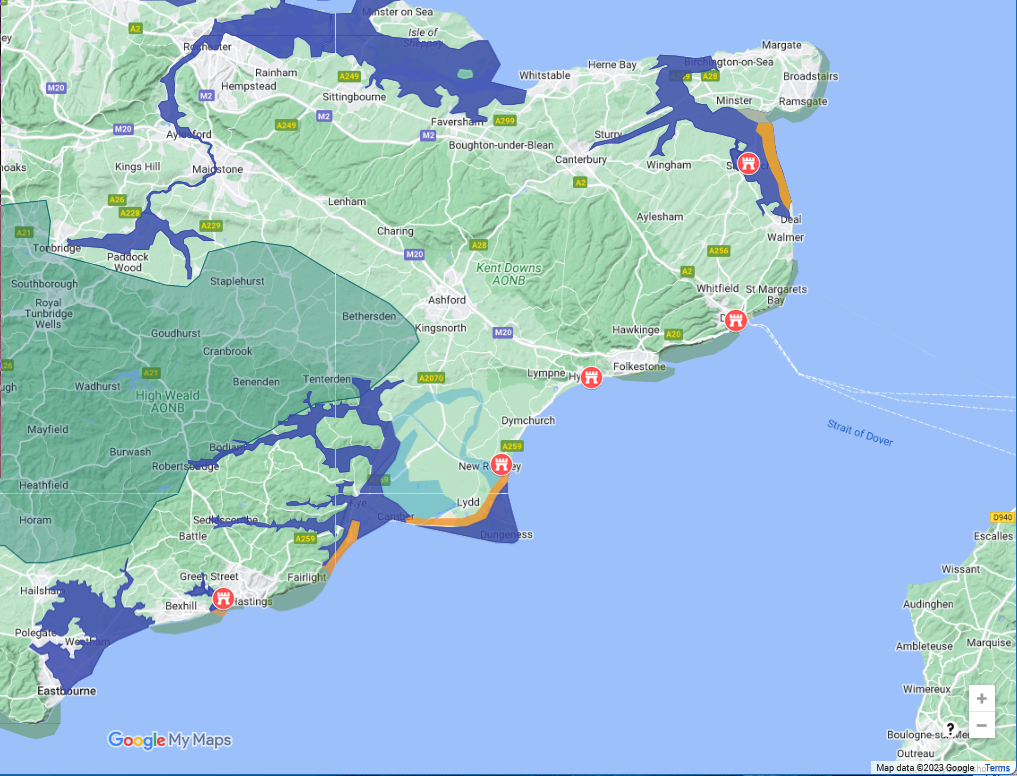 This Map is based on a Google Relief Map and shows the high tide level at 4.5
metres higher than today to reflect the high tide level at the time
This Map is based on a Google Relief Map and shows the high tide level at 4.5
metres higher than today to reflect the high tide level at the time
Hastings lost a large proportion of its ships and men and the old Hastings harbour in the Filsham valley was
now completely blocked.
New Romney suffered even more as the river Rother was now blocked completely at New Romney and broke through
the shingle bank where Old Winchelsea was located, about 10 miles(14 Km) away to the west.
Hythe was badly damaged but still usable
Dover was badly damaged but still usable
Sandwich was now isolated from the sea by the shingle bar from Deal having blocked the Wantsum channel
between Kent and the Isle of Thanet.
This has made 3 of the 5 ports pretty much useless so to continue with their supplying of vessels to the king they
allowed other places to join the Ports which then got the benefits of the Charter. Rye and Winchelsea were known as the
'Antient Towns' and the remainder of the other places were known as 'Limbs' of the main ports.
| | |
|---|
The addition of the ▲
|
|---|
So to mitigate the loss of ships and their supply to the King in order to keep their charter, the Cinque Ports organised
other local ports to supply ships and crew, and in return these became 'limbs' of the main ports and were given the same
benefits as the five original ports.
The various 'limbs' of the Cinque Ports which meant they had the same privileges are shown below, had to help the main
ports to allow them to provide enough vessels for the King during the 1200 & 1300's
- Hastings
- Ancient town of Rye(AD1190)
- Tenterden (limb of Rye)(AD1449)
- Ancient town of Winchelsea(AD1190)
- Guestling
- Bulverhythe
- Petit Iham (Pebsham nr Hastings)
- Northeye (an island in AD1287)
- Pevensey (an island in AD1287 joined before AD1230)
- Hydneye (nr Polegate - an island in AD1287)
- Seaford (joined before AD1229)
- Bekesbourne (nr Canterbury - inland now but on river in AD1285)(pre AD1596)
- Grange (nr Gillingham Kent joined before AD1285)(pre AD1596)
- New Romney
- Lydd(AD1155)
- Old Romney(pre AD1596)
- Dengemarsh (probably near Lydd)(pre AD1596)
- Oswaldstone (possibly near modern Greatstone/Littlestone)(pre AD1596)
- Bromehill (an island near to current Camber village)(pre AD1596)
Hythe
Dover
- Folkestone(AD1313)
- Faversham(AD1302)
- Margate(AD1424)
- St. Johns(pre AD1596)
- Goresend
- Birchington Wood(pre AD1596)
- Woodchurch
- St Peters(pre AD1596)
- Ringwold(pre AD1596)
- Kingsdown
Sandwich
- Deal(pre AD1596)
- Ramsgate(AD1353)
- Brightlingsea
- Fordwich(pre AD1596)
- Sturry
- Walmer(pre AD1596)
- Stonar(pre AD1596)
- Sarre(pre AD1596)
- St. Nicholas
- Reculver
| | |
|---|
Map of the Cinque Ports together with their Limbs after 1287 ▲
|
|---|
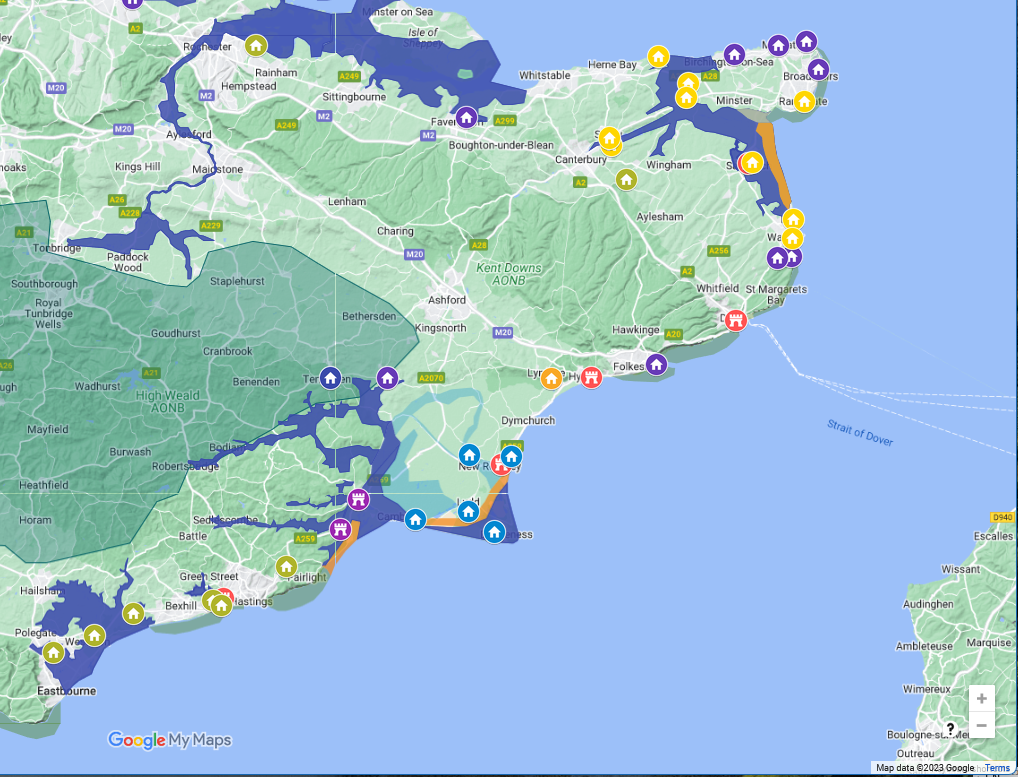 This Map is based on a Google Relief Map and shows the high tide level at 4.5
metres higher than today to reflect the high tide level at the time
This Map is based on a Google Relief Map and shows the high tide level at 4.5
metres higher than today to reflect the high tide level at the time
The Limbs of Hastings are shown as green settlements
The Limbs of New Romney are shown as pale blue settlements
The Limbs of Hythe are shown as orange settlements
The Limbs of Dover are shown as purple settlements
The Limbs of Sandwich are shown as yellow settlements
The antient towns of Rye and Winchelsea are shown as purple castles
Finally Tenterden is shown in dark blue and is a Limb of the Ancient town of Rye
| | |
|---|
Magna Carta AD1297 ▲
|
|---|
This is a translation of the relevent clause in the AD1297 Magna Carta that was signed by Edward I and included the
Cinque Ports.
(9) The city of London is to have all its ancient liberties and customs. Moreover we wish and grant that all other
cities and boroughs and vills and the barons of the Cinque Ports and all ports are to have all their liberties and free
customs.
| | |
|---|
| Map evidence from Symonson AD1596 ▲ |
|---|
On Symonson map of Kent from AD1596 there is a list of 'Portes and their members lyinge in
Kent'.
| Sandwich | Fordwich | 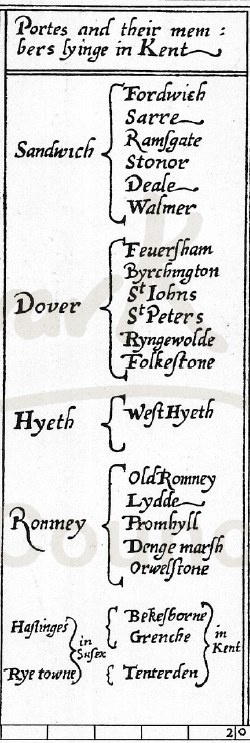 |
|---|
| Sarre |
|---|
| Ramfgate |
|---|
| Stonor |
|---|
| Deale |
|---|
| Walmer |
|---|
|
|---|
| Dover | Fordwich |
|---|
| Feuerfham |
|---|
| Byrchington |
|---|
| St Johns |
|---|
| St Peters |
|---|
| Ryngwolde |
|---|
| Folkeftone |
|---|
|
|---|
| Hyeth | WeftHyeth |
|---|
|
|---|
| Romney | Old Romney |
|---|
| Lydde |
|---|
| Promhyll |
|---|
| Denge marfh |
|---|
| Orwelftone |
|---|
|
|---|
| Haftinges | Bekesborne |
|---|
| Grenche |
|---|
|
|---|
| Rye towne | Tenterden |
|---|
| | |
|---|
| Other Reading ▲ |
|---|
There is a really good article on the 'The English Navy in the Twelfth Century' which comes from Cambridge University
please click the following link.
https://www.repository.cam.ac.uk/bitstreams/bd928f00-e498-4b1b-adf5-8b80c80e1492/download
|
|
|
|
|
| |
|
|
Local Interest
Just click an image |
|
|
|
|
|
|
|
|
|
|
|
|
| |
|
|